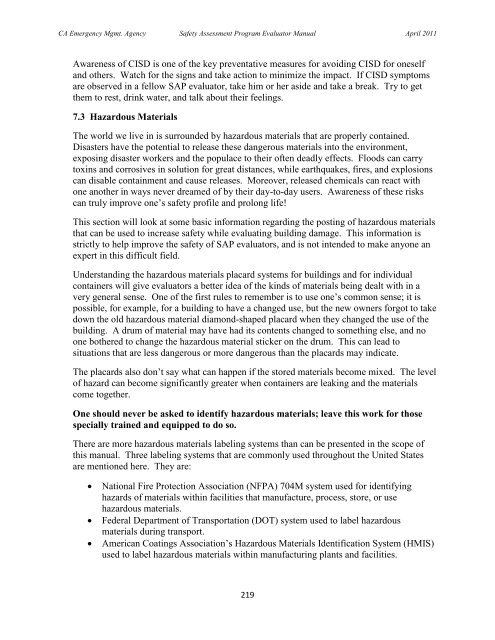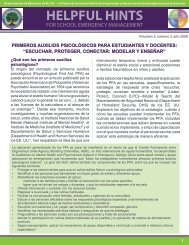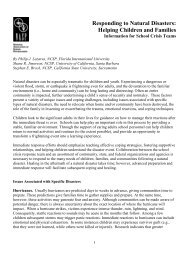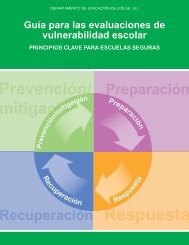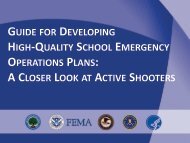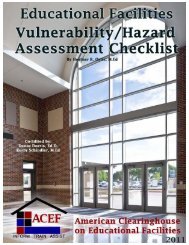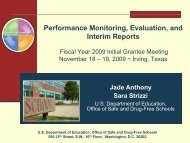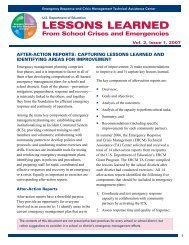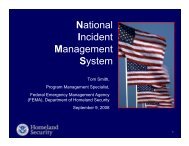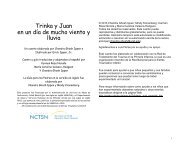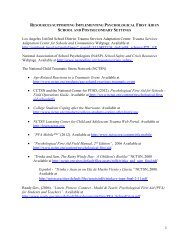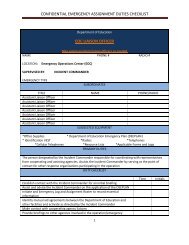Safety Assessment Program Evaluator Student Manual
Safety Assessment Program Evaluator Student Manual
Safety Assessment Program Evaluator Student Manual
You also want an ePaper? Increase the reach of your titles
YUMPU automatically turns print PDFs into web optimized ePapers that Google loves.
CA Emergency Mgmt. Agency <strong>Safety</strong> <strong>Assessment</strong> <strong>Program</strong> <strong>Evaluator</strong> <strong>Manual</strong> April 2011Awareness of CISD is one of the key preventative measures for avoiding CISD for oneselfand others. Watch for the signs and take action to minimize the impact. If CISD symptomsare observed in a fellow SAP evaluator, take him or her aside and take a break. Try to getthem to rest, drink water, and talk about their feelings.7.3 Hazardous MaterialsThe world we live in is surrounded by hazardous materials that are properly contained.Disasters have the potential to release these dangerous materials into the environment,exposing disaster workers and the populace to their often deadly effects. Floods can carrytoxins and corrosives in solution for great distances, while earthquakes, fires, and explosionscan disable containment and cause releases. Moreover, released chemicals can react withone another in ways never dreamed of by their day-to-day users. Awareness of these riskscan truly improve one‟s safety profile and prolong life!This section will look at some basic information regarding the posting of hazardous materialsthat can be used to increase safety while evaluating building damage. This information isstrictly to help improve the safety of SAP evaluators, and is not intended to make anyone anexpert in this difficult field.Understanding the hazardous materials placard systems for buildings and for individualcontainers will give evaluators a better idea of the kinds of materials being dealt with in avery general sense. One of the first rules to remember is to use one‟s common sense; it ispossible, for example, for a building to have a changed use, but the new owners forgot to takedown the old hazardous material diamond-shaped placard when they changed the use of thebuilding. A drum of material may have had its contents changed to something else, and noone bothered to change the hazardous material sticker on the drum. This can lead tosituations that are less dangerous or more dangerous than the placards may indicate.The placards also don‟t say what can happen if the stored materials become mixed. The levelof hazard can become significantly greater when containers are leaking and the materialscome together.One should never be asked to identify hazardous materials; leave this work for thosespecially trained and equipped to do so.There are more hazardous materials labeling systems than can be presented in the scope ofthis manual. Three labeling systems that are commonly used throughout the United Statesare mentioned here. They are:National Fire Protection Association (NFPA) 704M system used for identifyinghazards of materials within facilities that manufacture, process, store, or usehazardous materials.Federal Department of Transportation (DOT) system used to label hazardousmaterials during transport.American Coatings Association‟s Hazardous Materials Identification System (HMIS)used to label hazardous materials within manufacturing plants and facilities.219


